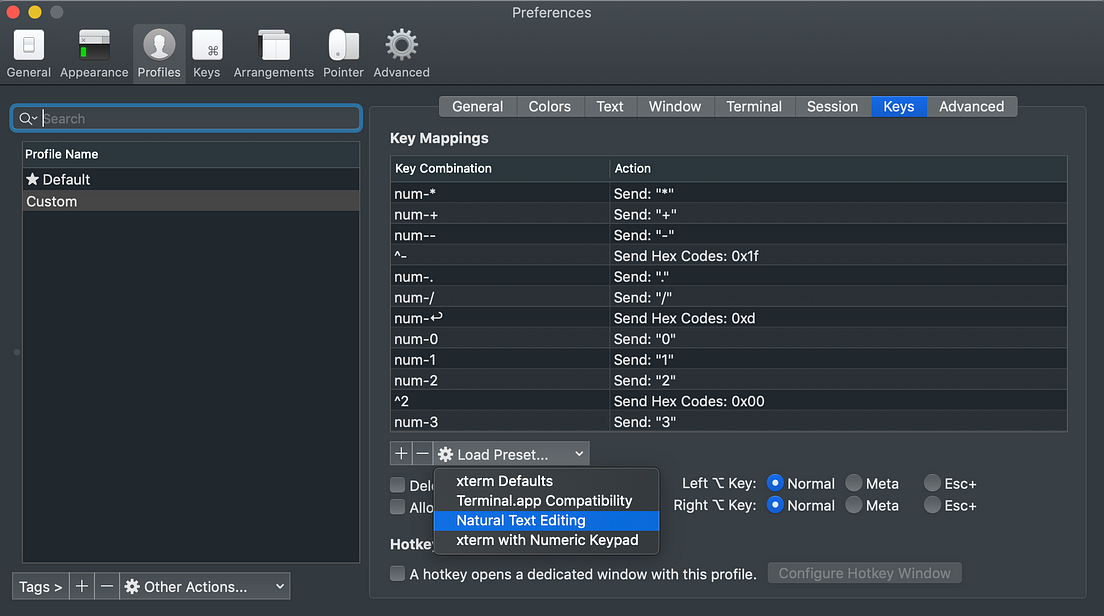
We will cover others two in the sections that follow. The first one we’re not interested in as it’s the standard way to select and copy text.

The big gain I was missing from tmux was the famed copy mode.Ī quick snippet from iTerm2’s documentation of highlights for text selection: To be honest, I don’t really need the session keeping functionality that tmux or screen provided. For the most part, I am able to use iTerm2 to open tabs, split panes and navigate around. One optimization within my terminal that I have been avoiding is tmux – it is unnecessarily complicated for what I need.
ITERM NAVIGATE WORDS WINDOWS
In addition, I use BetterSnapTool for MacOS, which allows me to move/resize windows around solely from my keyboard. I have taken such a liking to the Vim keyboard-bindings that I even use Vimium (a Google Chrome extension) for keyboard-driven navigation in my browser (for as much as I can). I heavily use Vim while editing which allows for keyboard navigation. Now control is near to my fingers when I use it and it makes my life easy.Where possible, I try to avoid using the mouse. If you want Backspace, set it to No Action. If you would like to change your Caps Lock key to Control, Option, or Shift, use the options in the dropdown. Click this and go to the Caps Lock drop down. MacOS: In System Preferences > Keyboard, you will find a bottom at the bottom right labeled Modifier Keys. Maximize a pane ⌘ + Shift + Enter (use with fullscreen to temp fullscreen a pane!)Īs many of the shortcuts use ctrl as their initials and caps-lock is the most unused key on the keyboard or at least for me, I’ve changed the mapping to the control key for it.Previous Tab ⌘+ Left Arrow - (I usually move by tab number).Go to Split Pane by Order of Use - ⌘ + ], ⌘ + [.Split Window Horizontally (same profile) - ⌘ + Shift + D (mnemonic: shift is a wide horizontal key).Split Window Vertically (same profile) - ⌘ + D.Go to Tab ⌘ + Number Key - (ie: ⌘2 is 2nd tab).
ITERM NAVIGATE WORDS MAC

Below is my agenda for the article to cover: And this doesn’t just apply to the command line but also when you use any kind of editor.Ī simple example could be navigating to a file to open it in the editor versus using a shortcut where-in you can simply type the filename to open it, when you do it you know which one is faster after attempts. The use of UI not only slows you down a few seconds each time you navigate through it but also gives you the freedom to not remember many shortcuts that are there to make your work life easier. And then no matter how productive you’re with UI you might suffer if you don’t know the command line well.Ī developer should try to reduce the use of mouse as much as they can - and the dependency on shortcuts has to be increased in order to boost productivity in long run. Additionally, it’s the world of containers, where you’ve to use the command line.


For example, many tools are now moving towards on-premise.
ITERM NAVIGATE WORDS SOFTWARE
So is it necessary to do modern-day software development? Well not really! You can still manage to do all the stuff, but you might be missing the fun and productivity which comes along with it. But devs who understand the command line would argue it’s one of the best tools at your disposal. For the uninitiated it can be daunting, stressful, and downright annoying. Some developers cringe at the mere thought of opening a terminal window.


 0 kommentar(er)
0 kommentar(er)
